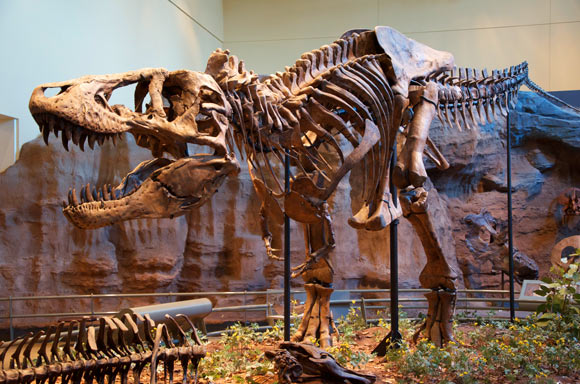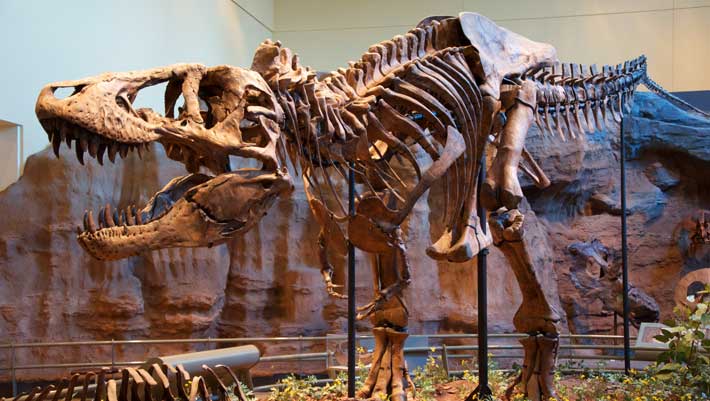While tyrannosaurid dinosaurs like Tyrannosaurus rex had skulls that were optimized for high bite forces, other gigantic carnivorous dinosaurs such as megalosauroids and allosauroids had much weaker bites and instead specialized in slashing and ripping flesh, according to an analysis by University of Bristol paleontologists.

Tyrannosaurus rex holotype specimen at the Carnegie Museum of Natural History, Pittsburgh, the United States. Image credit: Scott Robert Anselmo / CC BY-SA 3.0.
“Carnivorous dinosaurs took very different paths as they evolved into giants in terms of feeding biomechanics and possible behaviors,” said Dr. Andrew Rowe, a paleontologist at the University of Bristol.
“Tyrannosaurs evolved skulls built for strength and crushing bites, while other lineages had comparatively weaker but more specialized skulls, suggesting a diversity of feeding strategies even at massive sizes.”
“In other words, there wasn’t one ‘best’ skull design for being a predatory giant; several designs functioned perfectly well.”
Dr. Rowe and his colleague, Dr. Emily Rayfield, wanted to know how bipedalism influenced skull biomechanics and feeding techniques.
It was previously known that despite reaching similar sizes, predatory dinosaurs evolved in very different parts of the world at different times and had very different skull shapes.
Those facts raised questions about whether their skulls were functionally similar under the surface or if there were notable differences in their predatory lifestyles.
To examine the relationship between body size and skull biomechanics, the authors used 3D technologies including CT scans and surface scans analyze the skull mechanics, quantify the feeding performance, and measure the bite strength across 18 species of therapod, a group of carnivorous dinosaurs ranging from small to giant.
While they expected some differences between species, they were surprised when their analyses showed clear biomechanical divergence.
“Tyrannosaurids like Tyrannosaurus rex had skulls that were optimized for high bite forces at the cost of higher skull stress,” Dr. Rowe said.
“But in some other giants, like Giganotosaurus, we calculated stress patterns suggesting a relatively lighter bite.”
“It drove home how evolution can produce multiple solutions to life as a large, carnivorous biped.”
Skull stress didn’t show a pattern of increase with size. Some smaller therapods experienced greater stress than some larger species due to increased muscle volume and bite forces.
The findings show that being a predatory biped didn’t always equate to being a bone-crushing giant.
Unlike Tyrannosaurus rex, some dinosaurs, including the spinosaurs and allosaurs, became giants while maintaining weaker bites more suited for slashing at prey and stripping flesh.
“I tend to compare Allosaurus to a modern Komodo dragon in terms of feeding style,” Dr. Rowe said.
“Large tyrannosaur skulls were instead optimized like modern crocodiles with high bite forces that crushed prey.”
“This biomechanical diversity suggests that dinosaur ecosystems supported a wider range of giant carnivore ecologies than we often assume, with less competition and more specialization.”
The study appears this week in the journal Current Biology.
_____
Andre J. Rowe & Emily J. Rayfield. 2025. Carnivorous dinosaur lineages adopt different skull performances at gigantic size. Current Biology 35 (15): 3664-3673; doi: 10.1016/j.cub.2025.06.051

